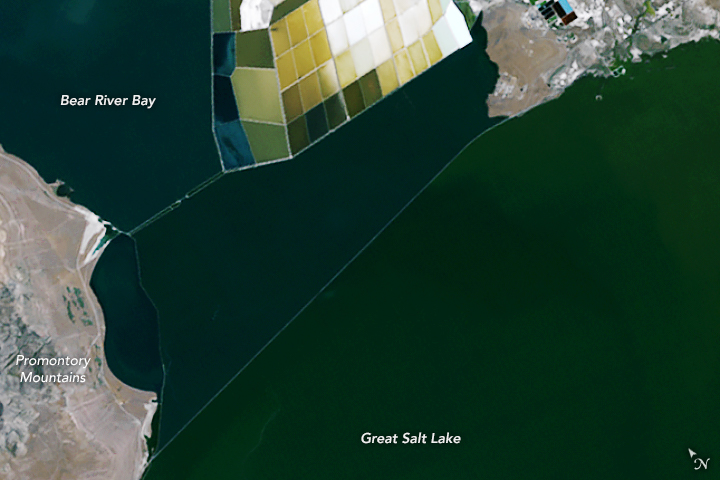
 Photo #: ISS063-E-40184 Date: Jul. 2020
Photo #: ISS063-E-40184 Date: Jul. 2020Geographic Region: USA-UTAH
Feature: BEAR RIVER BAY, SALT PONDS, GREAT SALT LAKE

 Photo #: ISS063-E-40184 Date: Jul. 2020 Photo #: ISS063-E-40184 Date: Jul. 2020Geographic Region: USA-UTAH Feature: BEAR RIVER BAY, SALT PONDS, GREAT SALT LAKE |
| While passing over northern Utah, an astronaut onboard the International Space Station (ISS) captured this photograph of an eastern portion of the Great Salt Lake. Water and sediment flow from Bear River Bay, past salt flats, and into the Great Salt Lake. These colorful salt flats are nestled between the Promontory Mountains and an industrial area to the east. Much of the light-colored area adjacent to the salt pans is dried lakebed. Named for the method of mineral extraction, solar evaporation ponds are key to this area's industry. These shallow, man-made salt pans slowly evaporate water, crystalizing minerals and making it easier for them to be bulldozed, collected, and processed for sale. Ranging from blue and green to orange and red, the color of each salt pan is dependent on the concentrations of salt, bacteria, and algae. In general, blue-hued ponds have lower salt levels than red or orange ponds. The second image, acquired by Landsat 5, depicts the same location in July 1985. The watersheds supplying Great Salt Lake experienced abnormally high amounts of precipitation throughout the early 1980s, causing the lake to rise to its historic high water elevation of 4,211 feet (1,284 meters) in 1986. Compared to the astronaut photograph, the Great Salt Lake was about 18 feet (5 meters) higher at the time, and many salt flats had a blue-green hue, indicating lower salinity and higher water levels. Due to years of drought and increasing human water use, the Great Salt Lake has since experienced significant reductions in water levels, leading to more exposure of lakebeds.  |
| Images: | All Available Images Low-Resolution 341k |
|
| Mission: | ISS063 |
|
| Roll - Frame: | E - 40184 |
|
| Geographical Name: | USA-UTAH |
|
| Features: | BEAR RIVER BAY, SALT PONDS, GREAT SALT LAKE |
|
| Center Lat x Lon: | 41.2N x 112.3W |
|
| Film Exposure: | N=Normal exposure, U=Under exposed, O=Over exposed, F=out of Focus |
|
| Percentage of Cloud Cover-CLDP: | 10 |
|
| Camera:: | N8 |
|
| Camera Tilt: | 13 | LO=Low Oblique, HO=High Oblique, NV=Near Vertical |
| Camera Focal Length: | 800 |
|
| Nadir to Photo Center Direction: | E | The direction from the nadir to the center point, N=North, S=South, E=East, W=West |
| Stereo?: | Y=Yes there is an adjacent picture of the same area, N=No there isn't |
|
| Orbit Number: | |
|
| Date: | 20200705 | YYYYMMDD |
| Time: | 144818 | GMT HHMMSS |
| Nadir Lat: | 41.5N |
Latitude of suborbital point of spacecraft |
| Nadir Lon: | 113.1W |
Longitude of suborbital point of spacecraft |
| Sun Azimuth: | 83 | Clockwise angle in degrees from north to the sun measured at the nadir point |
| Space Craft Altitude: | 222 | nautical miles |
| Sun Elevation: | 28 | Angle in degrees between the horizon and the sun, measured at the nadir point |
| Land Views: | |
|
| Water Views: | |
|
| Atmosphere Views: | |
|
| Man Made Views: | |
|
| City Views: | |
|
Photo is not associated with any sequences | ||
| NASA Home Page |
JSC Home Page |
JSC Digital Image Collection |
Earth Science & Remote Sensing |
|
|